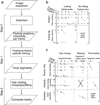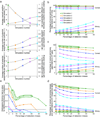Robust single-particle tracking in live-cell time-lapse sequences
- PMID: 18641657
- PMCID: PMC2747604
- DOI: 10.1038/nmeth.1237
Robust single-particle tracking in live-cell time-lapse sequences
Abstract
Single-particle tracking (SPT) is often the rate-limiting step in live-cell imaging studies of subcellular dynamics. Here we present a tracking algorithm that addresses the principal challenges of SPT, namely high particle density, particle motion heterogeneity, temporary particle disappearance, and particle merging and splitting. The algorithm first links particles between consecutive frames and then links the resulting track segments into complete trajectories. Both steps are formulated as global combinatorial optimization problems whose solution identifies the overall most likely set of particle trajectories throughout a movie. Using this approach, we show that the GTPase dynamin differentially affects the kinetics of long- and short-lived endocytic structures and that the motion of CD36 receptors along cytoskeleton-mediated linear tracks increases their aggregation probability. Both applications indicate the requirement for robust and complete tracking of dense particle fields to dissect the mechanisms of receptor organization at the level of the plasma membrane.
Figures




Comment in
-
Single-particle tracking: connecting the dots.Nat Methods. 2008 Aug;5(8):671-2. doi: 10.1038/nmeth0808-671. Nat Methods. 2008. PMID: 18668034 No abstract available.
References
-
- Sako Y, Minoguchi S, Yanagida T. Single-molecule imaging of EGFR signalling on the surface of living cells. Nat Cell Biol. 2000;2:168–172. - PubMed
-
- Groc L, et al. Differential activity-dependent regulation of the lateral mobilities of AMPA and NMDA receptors. Nat Neurosci. 2004;7:695–696. - PubMed
-
- Meijering E, Smal I, Danuser G. Tracking in molecular bioimaging. IEEE Signal Proc Mag. 2006;23:46–53.
-
- Kalaidzidis Y. Intracellular objects tracking. Eur J Cell Biol. 2007;86:569–578. - PubMed
Publication types
MeSH terms
Substances
Grants and funding
LinkOut - more resources
Full Text Sources
Other Literature Sources

